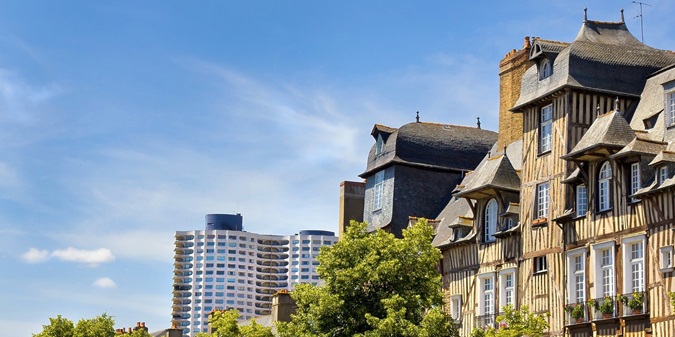DISCOVER OUR PROPERTIES FOR SALE IN RENNES
Rennes, located in northwestern France, is the capital of the Ille-et-Vilaine department and the Brittany region. Positioned in Upper Brittany at the confluence of the Ille and the Vilaine rivers, Rennes has a central population of 225,000, making it the largest city in Brittany, the second largest in the Grand Ouest region, and the eleventh most populated city in France. In 2021, the urban unit of Rennes gathered 371,000 residents, while the greater metropolitan area reached a population of 771,000, ranking it tenth nationally. Rennes also serves as the seat of a metropolitan community of 462,580 residents (2020), placing it among France's eleven major metropolitan centers.
Since the Gallo-Roman era, Rennes, founded under the name Condate by the Riedones, saw its political influence grow during the Middle Ages as it became first a fortress on the Breton Marches, then the capital of the Duchy of Brittany. Under the Ancien Régime, the integration of Brittany into France eventually relegated Rennes to the status of a major provincial city. However, the establishment of the Breton Parliament in the 16th century enabled the region to maintain a degree of autonomy until the Revolution. After a devastating fire in 1720, the city’s wooden center was rebuilt in stone. Remaining largely rural until the 20th century, Rennes experienced significant growth during this time.
Starting in the 1950s, Rennes, nicknamed the “city of administrations,” underwent substantial economic and demographic growth, spurred by rural migration and new industrialization. In the 1980s and 1990s, the city gained a foothold in telecommunications, establishing itself as a key tertiary hub focused on emerging technologies, with the Rennes Atalante technopole and the Images et Réseaux business cluster.
Beyond its economic vitality, Rennes is also a major university city, ranking as the second largest student city in France. Designated a “City of Art and History,” it has preserved a rich medieval and classical heritage in its historic center, with 90 buildings protected as historical monuments. In 2018, it was named “Best City to Live In” by L'Express magazine.
In 2019, Rennes had 129,917 housing units, with 89.5% classified as primary residences, 3.8% as secondary homes, and 6.7% as vacant properties. Apartments made up 85.9% of the total housing stock.
The majority of Rennes residences comprise four or more rooms, followed by three-room and two-room homes (22%). The city’s housing is well-equipped, with nearly all properties having central or individual heating, and more than half offering a garage, storage space, or parking. In 2012, almost a third of Rennes' housing stock consisted of buildings less than 18 years old, ranking the city third nationwide in terms of housing modernity.
In 2005, under the framework of its Urban Project 2015, Rennes organized its development around seven thematic priorities, aiming to strengthen its role as the central city of a dynamic metropolitan region while preserving its qualities as a friendly, accessible ecocity. To achieve these objectives, the city prioritized the implementation of Zone d’Aménagement Concerté (ZAC) procedures, creating more than thirty ZACs since the 1970s. During the 2010s, several major development projects emerged:
- Beauregard District, with three ZACs established in 1993, 2005, and 2006, including the bioclimatic residence Salvatierra.
- Alma-Fréville Axis, restructured with four ZACs created between 2002 and 2004, involving the construction of 700 homes along with new commercial and office spaces.
- La Courrouze ZAC, launched in 2003 and extending across Rennes and Saint-Jacques-de-la-Lande, plans for 5,000 homes on former military grounds, including the arsenal.
- Baud-Chardonnet ZAC, established in 2004, to host 2,200 housing units and 84,000 square meters of office space on a reclaimed industrial site.
- EuroRennes ZAC, an expansive 58-hectare project around Rennes’ central station, aims to create a business district. Scheduled for completion in 2025, it will include 150,000 square meters of office space, 30,000 square meters for retail and services, 1,500 housing units, 10,000 square meters for activities and facilities, and 15,000 square meters of accommodations.
- ViaSilva ZAC, covering 570 hectares and encompassing the Rennes Atalante Technopole, as well as the municipalities of Cesson-Sévigné and Thorigné-Fouillard. This last major urban reserve within the ring road will host the terminus of metro line b and is projected to accommodate more than 40,000 residents and 25,000 jobs.
Additionally, several smaller-scale projects have been carried out under the ZAC procedure, including the redevelopment of the former Brittany Paper Mills (rue de Lorient), the old Saint-Hélier Brewery, and the former Mac-Mahon Barracks.

